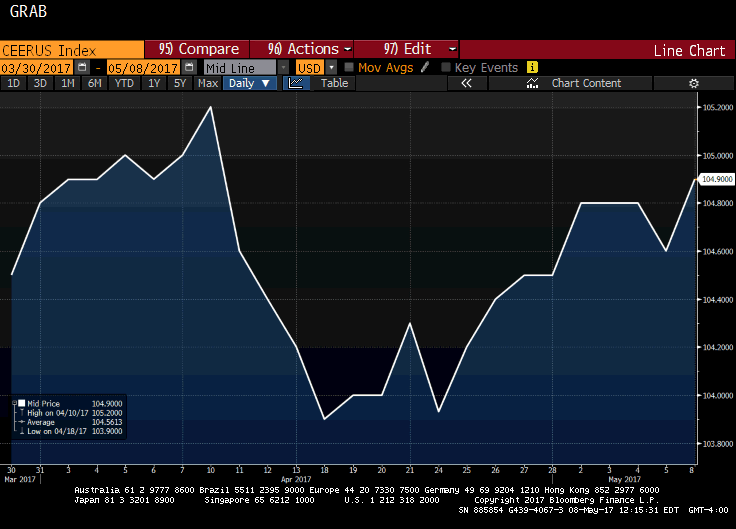Summary:
US TWI has appreciated a little since the end of Q1.
The euro and sterling’s strength are exceptions to the rule.
The dollar has edged up against the currencies of the US top four trading partners here in Q2.
| In early Asia today, the euro reached its highest level against the dollar since the US election last November. Sterling was near seven-month highs. It is primarily because of the strength of these two currencies that many characterize the dollar as weak.
While the euro and sterling are important currencies, their strength overstates the weakness of the US dollar. The Federal Reserve’s measures of the trade-weighted dollar are calculated on a monthly basis. The Bank of England has trade-weighted indices for many currencies, and they are updated fairly. The Great Graphic, created on Bloomberg, shows the BOE’s trade-weighted dollar since the end of March. The TWI peaked on April 10 at 105.20 and then fell to 103.90 within eight days. Today it is back at 104.90. The BOE’s trade-weighted dollar averaged 102.20 last year. Through April, it has averaged almost 104.60 this year. Consider the dollar’s performance against its four largest trading partners: Canada, China, Mexico, and Japan. Since the end of March, the Canadian dollar has fallen by 2.8%. It is the second worst major currency after the Australian dollar (-3.4%) over this period. The Japanese yen has fallen nearly 1%. China’s yuan is off 0.2%. The Mexican peso has depreciated by almost 2.5%. |
BOE Trade-Weighted Dollar |
Sterling and the euro are exceptions to the strength of the dollar reflected in the trade-weighted measure. Sterling is up 3.7%, and the euro is up 2.4% over this period. Sterling has boosted by May’s call for snap elections on ideas that by strengthening the government’s mandate, a better deal can be cut with the EU. This does seem very persuasive as the recent summit makes clear. May’s mandate is not the issue.
The illusions that Merkel and Juncker suggested UK officials are operating under have nothing to do with the Tory’s political mandate. It is about what cost (monetary and opportunity) of the divorce. One member of the MPC dissented at the last BOE meeting in favor of an immediate hike, and Forbes will likely dissent again at this week’s meeting. However, if anything, short-term UK rates has softened slightly since the end of the first quarter.
Adjustment to the speculative sterling position in the futures market may seem counter-intuitive. Since the end of March, the gross short sterling position fell 3.5k contracts to 135.6k. As a point of reference, the record was set last October near 154k. The shorts have barely squared up despite the appreciation in the spot market. What has happened is new longs have been established. Since the end of March, the gross longs have grown almost 20k contracts to 54.3k.
The euro’s rise has been helped by ideas that a consensus is emerging to change the ECB’s forward guidance. Specifically, many are anticipating a change in the either the risk assessment or in the assessment that rates will remain at present levels “or lower.” The euro’s gains against the dollar have also been aided by the single currencies 8.6% rally against the yen since mid-April. The US two-year premium over Germany peaked on March 9 near 223 basis points. It fell to 192 basis points on April 24 as the market responded to Macron’s victory in the first round of the French presidential contest. It is now a little below 200 basis points, which is where the 20-day average can be found.
The net short speculative euro position in the futures stands at its lowest level since mid-2014 as of May 2. However, the speculators have a somewhat smaller gross long position. The gross shorts were trimmed, which explains most of the modest reduced in the net short position since the end of Q1.
Full story here Are you the author? Previous post See more for Next post
Tags: #GBP,#USD,$CAD,$EUR,Great Graphic,MXN,newslettersent






































